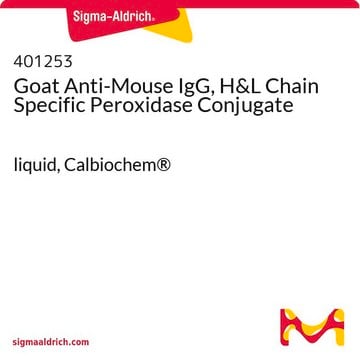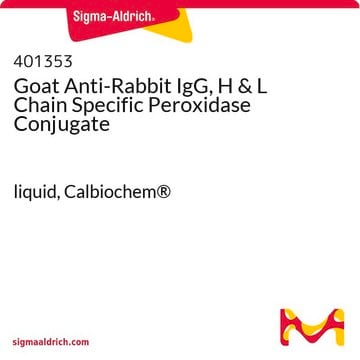AP181R
Goat Anti-Mouse IgG Antibody, Rhodamine conjugate, Species Adsorbed
1.4 mg/mL, Chemicon®
Sign Into View Organizational & Contract Pricing
All Photos(1)
About This Item
UNSPSC Code:
12352203
eCl@ss:
32160702
NACRES:
NA.46
Recommended Products
biological source
goat
Quality Level
conjugate
TRITC conjugate
rhodamine conjugate
antibody form
affinity isolated antibody
antibody product type
secondary antibodies
clone
polyclonal
species reactivity
mouse
manufacturer/tradename
Chemicon®
concentration
1.4 mg/mL
technique(s)
immunofluorescence: suitable
shipped in
wet ice
target post-translational modification
unmodified
Specificity
Mouse IgG (H+L) (absorbed for minimal cross-reactivity to Rat, Human, Bovine and Horse Serum Proteins)
FLUOROPHORE/ PROTEIN ABSORBANCE RATIO:
Tetramethyl Rhodamine Isothiocyanate A550/A280 = 0.57
FLUOROPHORE/ PROTEIN ABSORBANCE RATIO:
Tetramethyl Rhodamine Isothiocyanate A550/A280 = 0.57
Application
Goat anti-Mouse IgG Antibody, Rhodamine conjugate, Species Adsorbed detects level of Mouse IgG & has been published & validated for use in IF.
Physical form
Lyophilized. Buffer = 0.01 M Sodium Phosphate, 0.25 M NaCl, pH 7.6 and 0.05%Sodium azide.
RECONSTITUTION:
Reconstitute to 1 mg/mL with sterile distilled water.
RECONSTITUTION:
Reconstitute to 1 mg/mL with sterile distilled water.
Legal Information
CHEMICON is a registered trademark of Merck KGaA, Darmstadt, Germany
Not finding the right product?
Try our Product Selector Tool.
Hazard Statements
Precautionary Statements
Hazard Classifications
Aquatic Chronic 3
Storage Class Code
11 - Combustible Solids
WGK
WGK 3
Certificates of Analysis (COA)
Search for Certificates of Analysis (COA) by entering the products Lot/Batch Number. Lot and Batch Numbers can be found on a product’s label following the words ‘Lot’ or ‘Batch’.
Already Own This Product?
Find documentation for the products that you have recently purchased in the Document Library.
Ye Chang et al.
International journal of molecular medicine, 41(1), 33-42 (2017-11-09)
This study aimed to explore whether angiotensin II (Ang II) inhibits the proliferation of human umbilical vein endothelial cells (HUVECs) by changing mitochondrial energy metabolism, and whether atorvastatin has a protective role via restoration of endothelial function. HUVECs were treated with 1 µM Ang II alone
Natsumi Maruyama et al.
The Journal of reproduction and development, 69(6), 328-336 (2023-11-06)
Senescent cells play a detrimental role in age-associated pathogenesis by producing factors involved in senescence-associated secretory phenotype (SASP). The present study was conducted to examine the possibility that senescent cells are present in aged ovaries and, if so, to determine
Danielle A Guimarães et al.
Redox biology, 6, 386-395 (2015-09-08)
Imbalanced matrix metalloproteinase (MMP)-2 activity and transforming growth factor expression (TGF-β) are involved in vascular remodeling of hypertension. Atorvastatin and sildenafil exert antioxidant and pleiotropic effects that may result in cardiovascular protection. We hypothesized that atorvastatin and sildenafil alone or
Selim Cellek et al.
Gastroenterology, 133(1), 175-183 (2007-07-17)
Although the beta(3)-adrenoceptor (AR) has been suggested to be involved in regulation of gut motility and visceral algesia, the precise mechanisms have been unknown. beta(3)-AR has been postulated to have a nonneuronal expression, being initially characterized in adipocytes and subsequently
Yuan Li et al.
Molecular medicine reports, 15(5), 2673-2680 (2017-04-28)
Advanced glycation end products (AGEs) restrain the proliferation of endothelial cells, which is an important determinant of diabetic vasculopathy. Mitochondrial biogenesis serves an essential role in cellular adaptation and repair. The current study aimed to investigate alterations in mitochondrial energy
Our team of scientists has experience in all areas of research including Life Science, Material Science, Chemical Synthesis, Chromatography, Analytical and many others.
Contact Technical Service







